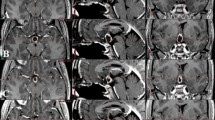Abstract
Objectives
In 1996 we published our results for treatment of childhood craniopharyngioma. That study did not only reveal that there was a significant morbidity associated with our then policy of attempted radical removal followed by post-operative radiotherapy in those cases with residual disease, but also that risk factors for poor outcome could be identified based on the clinical and radiological findings at presentation. As result of that study, we redefined the role of radical surgery in the treatment of craniopharyngioma and developed a new treatment strategy in an attempt to improve the quality of outcome without compromising tumour control. Our aims in this paper were to compare the results of our current treatment strategy with that reported in the 1996 paper to assess whether we have achieved this goal.
Methods
A detailed assessment of the treatment pathway and outcome was undertaken for children treated for craniopharyngioma in our unit from 1996 to 2004. This included a morbidity score based on visual, motor, cognitive, hypothalamic and endocrinological data obtained from our neuro-oncology database and review of clinical records. Where possible we have attempted to record data in the same manner as for our previous study allowing for meaningful comparison.
Results
Forty-eight children with craniopharyngioma presented in the study period. On the basis of clinical presentation and radiological findings, 25 were deemed suitable for attempted radical surgery and 23 were treated with various subtotal surgical procedures. Radiotherapy was used in patients over the age of 5 years where residual tumour was present or progressed after the initial surgical intervention(s). Morbidity scores, particularly in relation to visual and cognitive outcome, are improved and there was no surgical mortality in the current series.
Conclusions
A treatment paradigm for childhood craniopharyngioma is presented which improves the quality of outcome without compromising tumour control.





Similar content being viewed by others
References
De Vile CJ, Grant DB, Hayward RD, Kendall BE, Neville BG, Stanhope R (1996) Obesity in childhood craniopharyngioma: relation to post-operative hypothalamic damage shown by magnetic resonance imaging. J Clin Endocrinol Metab 81:2734–2737
De Vile CJ, Grant DB, Kendall BE, Neville BG, Stanhope R, Watkins KE, Hayward RD (1996) Management of childhood craniopharyngioma: can the morbidity of radical surgery be predicted? J Neurosurg 85:73–81
Hayward R, De Vile CJ, Brada M (2004) Craniopharyngioma. In: Walker D, Perilongo G, Punt J, Taylor R (eds) Brain and spinal tumours of childhood. Arnold, London, pp 370–386
Hoffman HJ, De Silva M, Humphreys RP, Drake JM, Smith ML, Blaser SI (1992) Aggressive surgical management of craniopharyngiomas in children. J Neurosurg 76:47–52
Kang JK, Lee KS, Hong YK, Jeun SS, Kim MC (2005) Endocrine management following craniopharyngioma surgery in children. Childs Nerv Syst 19:625
Mottolese C, Stan H, Hermier M, Berlier P, Convert J, Frappaz D, Lapras C (2001) Intracystic chemotherapy with bleomycin in the treatment of craniopharyngiomas. Childs Nerv Syst 17:724–730
Sanford RA (1994) Craniopharyngioma: results of survey of the American Society of Pediatric Neurosurgery. Pediatr Neurosurg 21(Suppl 1):39–43
Wisoff JH, Sands S, Moliterno J, Milner J (2005) Functional outcome following radical resection of primary and recurrent craniopharyngioma. Childs Nerv Syst 19:624
Yasargil MG, Curcic M, Kis M, Siegenthaler G, Teddy PJ, Roth P (1990) Total removal of craniopharyngiomas. Approaches and long-term results in 144 patients. J Neurosurg 73:3–11
Acknowledgements
The authors would like to acknowledge Mr. M. Powell, Consultant Neurosurgeon (National Hospital for Neurology and Neurosurgery, Queen Square) for providing his expertise in trans-sphenoidal surgery in the management of our patients.
Author information
Authors and Affiliations
Corresponding author
Rights and permissions
About this article
Cite this article
Thompson, D., Phipps, K. & Hayward, R. Craniopharyngioma in childhood: our evidence-based approach to management. Childs Nerv Syst 21, 660–668 (2005). https://doi.org/10.1007/s00381-005-1210-9
Received:
Published:
Issue Date:
DOI: https://doi.org/10.1007/s00381-005-1210-9




